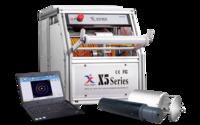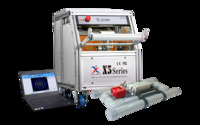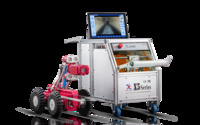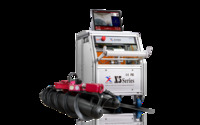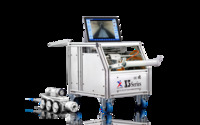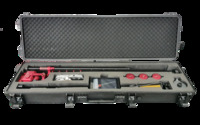X4 Pipe Sonar System
Specifications
X4 Pipeline Sonar Pipe Inspection Equipment/System is mainly used for the detection of water-carrying pipes (full water or above 2/3 of the water level), inspection wells, or underground cavities.
It automatically analyzes and extracts the inner wall contour, establishes a three-dimensional model, and performs the quantitative analysis.
X4 Pipe Sonar System Main Parts
Sonar Probe
Size: total length: 485mm, diameter: 70mm;
Material: aluminum alloy shell;
Waterproof: IP68;
Operating temperature: 0~40℃;
Storage temperature: -20~70℃;
Weight in air: 2.7kg;
Acoustic frequency: 1MHz;
Beam width: 1.1deg (-3db), conical beam;
Range resolution (0.125m range) : 0.5mm;
Maximum applicable pipe diameter: 6000mm;
Transmitting pulse width: 4~20us;
Receiving bandwidth: 500KHz;
Power supply: 48V dc;
Cable Reel
Cable length: 150m (customizable)
Motor-driven
2-pin cable, drawing anti-Kevlar 300 kg, imported polyurethane sheath, cable diameter <6mm, waterproof, wear, acid, corrosion.
Cable retracting automatically or manually
Accurate cable counter, devition within 1mm
Compatible with Easy-Sight X5-H series crawlers and X4 sonar pipe inspection system
Protection class: IP63
Dimension( LxWxH): 570x395x475mm
Weight: about 45 kg( with 150m cable)
Main Controller
Regular computer or tablet can be used at main controller with build-in inspection collection software. Both main controller and joystick can control the crawler forward, back and turn, camera
rotating, light and so on. Equipped with PipeSonar pipeline sonar imaging analysis report software, installed on the computer, and connected to the cable tray via WIFI line, used for real-time
display and collection of inspection images during the inspection process, and can perform contour extraction, interpretation analysis, three-dimensional reconstruction and Report output.
Probe Floating Bucket
Materials: stainless steel,suitable pipe width: DN300mm~6000mm;
Size:220mm * 70mm * 400mm;
Weight:2kg;
Flotage: 5kg.
SONAR SEWER INSPECTION SYSTEM ADVANTAGES
Sonar sewer inspection systems offer several advantages for assessing the condition of underground sewer infrastructure.
Non-Destructive Testing: Sonar inspection is a non-destructive testing method, which means it doesn't require physical access to the sewer system or any invasive procedures. This helps in
minimizing disruption to the sewer network and reduces the need for extensive excavation.
Comprehensive Imaging: Sonar technology can provide comprehensive imaging of the internal structure of sewer pipes. It generates detailed visualizations of the pipe's interior, allowing inspectors
to identify cracks, corrosion, blockages, root intrusions, and other issues.
Accurate Mapping: Sonar systems can create accurate maps of sewer systems, including pipe shapes, sizes, and lengths. This information is crucial for planning maintenance, repairs, and upgrades.
Remote Operation: Sonar inspections can often be conducted remotely, minimizing the need for personnel to physically enter hazardous or difficult-to-reach environments. This improves safety and
reduces potential health risks for workers.
Real-Time Data: Many sonar sewer underwater pipeline inspection systems provide real-time data analysis. This enables inspectors to make immediate decisions based on the information they're
receiving, which is particularly valuable for addressing urgent issues.
If you want to know more kinds of smart drainage system, please visit our website.
- Country: China (Mainland)
- Founded Year: 2010
- Address: No.9-2, Wudayuan No.1 Road, GEO OFFICE,Donghu High-tech Development Zone, Wuhan, Hubei,China
- Contact: Pipedetect com

